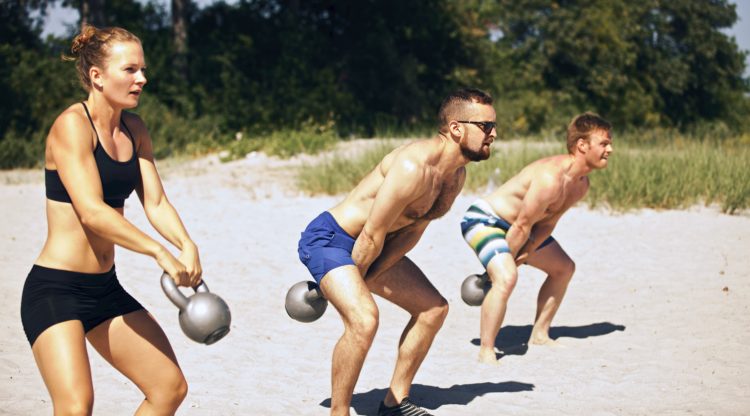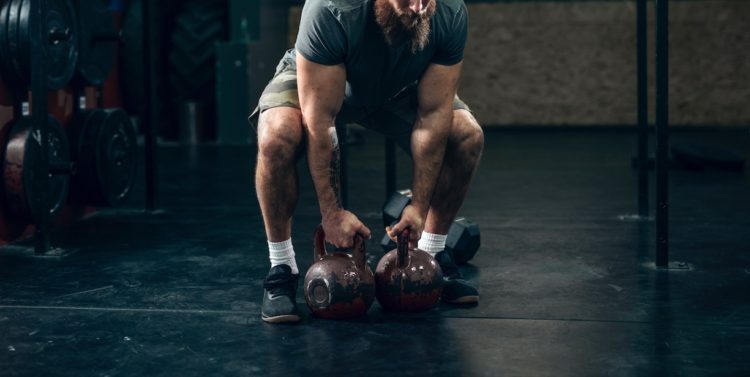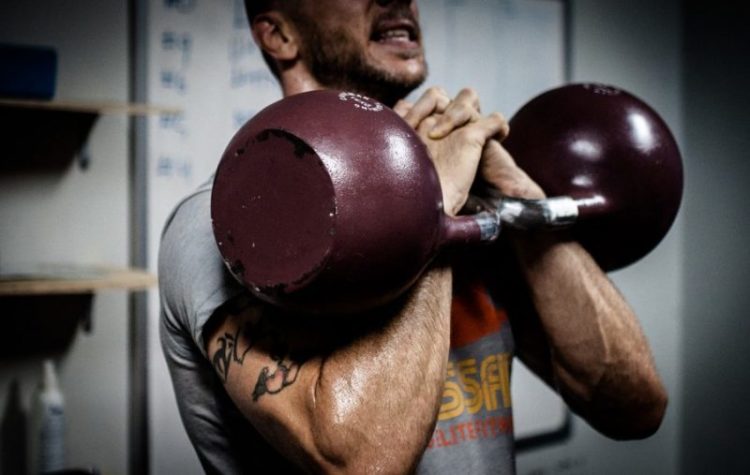You want to start working with kettlebells because you’ve seen other people swinging ‘em around and let’s be real: they look badass. Or you have worked with kettlebells before, but you’re looking to take your relationship with the strength and conditioning creatures to the next level. Whatever your current status is with them, you should know that kettlebells are excellent strength-building tools and can totally advance your body composition goals if you want to lose body fat with kettlebells, too.
But you might be accustomed to using your bodyweight as an endurance athlete, or controlled movements as a weightlifter, or powerful but largely barbell-oriented movements if CrossFit is your thing.
These are very different movement patterns than the often unexpected-looking kettlebell movements like two-handed swings, kettlebell cleans, and the one-armed swing that guy in the gym does. That movement that looks magical because he literally let the bell go at the top of the movement, it hovers for a moment, and then he deftly catches it in his opposite hand on the way down.
If you’re trying to be that kind of cool — or if you’re just wanting to up your strength and conditioning game — you might have some questions about kettlebells that you’ve been embarrassed to ask. Don’t worry: questions are good. They’re how you grow. So here are some questions you’ve probably had about kettlebells, answered.
Editor’s note: This article is an op-ed. The views expressed herein and in the video are the author’s and don’t necessarily reflect the views of BarBend. Claims, assertions, opinions, and quotes have been sourced exclusively by the author.

Form
Proper form is the centerpiece of any workout. (Or at least, it should be.) And proper form is extremely important when you’re training with kettlebells. These tools are often used for relatively high-velocity lifts, which often involve potentially awkward, uncomfortable, or straight-up painful positions relative to your body (spoiler: if it’s hurting in a non-injury-related way, you’ve got to correct your form).
1. Where do I grip the darn thing?
As ever, your grip depends on your lift. If you’re doing something like kettlebell swings, you can feel free to grip the bell comfortably in the center of the handle (more on what that grip should feel like below). But if you’re going for kettlebell cleans, snatches, or Turkish get-ups, your grip gets a little more complicated.
These are lifts where you want an off-set grip. Start by clasping the handle, palm down, in the center (you should be looking at your knuckles). This is just to orient your body: you’re going to shift your grip now. If the handle is in your right hand, shift your grip to the left. If the handle is in your left hand, shift your grip to the right. Why? The pad between your thumb and your index finger should be right next to the curve of the handle (left side if it’s your right hand, right side if it’s your left hand). The part of your grip between your thumb and index finger should meet the handle were it starts to curve down to meet the floor/the bell itself.
And if you’re preparing to lift off the ground for a clean or a snatch, twist your hand and the bell so that your thumb is facing behind you. This will make for a much cleaner clean (I couldn’t resist).
[Related: Why kettlebell swings benefit any type of athlete]
2. How tight should I keep my grip/fingers around the bell?
At the top of a swing, you should be able to lightly flutter your fingers off of the bell. This does not mean that your grip should be uncomfortably loose, or that the thing should start flying with each rep. But, keeping an iron grip on the handle will radiate tension up your forearms and through your elbow that will exert sheering forces on your body, rather than making your lift smoother. Remember that power is being generated from the hips, not the arms, and certainly not the hands. And grasping harder won’t make your grip stronger, either: don’t worry, your grip will get plenty strong once you’ve got enough weight and reps in your hands.
3. What do my elbows do during kettlebell swings?
Just like you’re keeping your grip firm but soft, you want to keep your elbows firm but soft. What the heck does that mean? Please, for the love of your elbow health, do not keep your arms locked out while you’re swinging. But, you also don’t want to T-rex arm your way through swings, either. Remember, again, that swinging should come pretty much entirely from your hips, and your arms are just levers to proper the weight along its merry way. So keep your elbows un-locked (aka, soft) but not quite bent, and you’ll be in good shape.
4. How… do I not hit my crotch with kettlebell swings?
Ah yes. My clients are always concerned about this, and understandably so! Ideally, your swing should send the bell behind your body (under and behind your butt) such that if someone put a yoga block behind and between your upper thighs, the bell should, well, tap the block. But how to do this without extremely awkward pain?
Two answers: one, again, make sure the swing is coming from your hips. Imagine that your hip is a hinge connecting your upper and lower body. Keeping a neutral back, you want to use that hinge to propel the motion of a swing. Doing this should give you enough clearance to not hit your crotch with the bell.
Two, use the cue that your forearms should touch your upper inner thighs at the lowest part of your swing. This way, you’ll always have enough clearance, and peace of mind.
5. Why are kettlebell cleans so painful for my forearms?
They shouldn’t be! If your kettlebell cleans or snatches are thumping the bell down painfully on the back of your forearm, you need to make some adjustments. This is where your grip comes in. The closer your thumb and index finger are to the curve of the handle, the easier the hand should be able to flip through the bell. Cue yourself to slip your arm under the bell at the top catch of the lift, rather than cueing yourself to flip the bell over. Let gravity flip the bell as you focus on getting your grip and hand positioned properly. It’ll take practice and a lot of mental focus, but that cue and proper grip are going to help you (and your poor, bruised forearm) tremendously. Feel free to throw on some forearm guards if you want to protect yourself while you’re still perfecting your form.
[Related: 10 kettlebell exercises every athlete should master]
Programming
6. Can I add kettlebells to a pre-written workout?
It depends on your program and on your goals! If you’re an endurance athlete looking to make some serious strength gains and you’re not a few weeks out from your next race, sure thing! Making your body stronger and gaining more muscle mass overall — and accruing the anaerobic benefits that can come from kettlebell lifts — is only going to help your endurance work.
And if you’re a lifter looking to improve your conditioning, absolutely you can. (Although, of course, if you’re in-season and training for a specific competition, you might want to stick to your current program for now.) Just make sure to be smart about where you’re putting your kettlebell work within the program, how heavy you’re going, and how much volume you’re doing. You can definitely use kettlebells as finishers to your powerlifting workouts, and as low-impact substitutes for running when you need to improve your conditioning.
To figure out how best to integrate kettlebells into your program, ask yourself if there’s something you can swap out for some kettlebell training. Are you spending a few mindless minutes to do your duty to cardio and conditioning every day before and/or after your training? Think about swapping that out for some intentional (and light!) kettlebell warmups or cooldowns.
And if you have a day dedicated to cardio, there’s your chance to slip in kettlebells. And if your program is all strength-strength-strength, sounds like you can use some conditioning. Just be judicious to start. Adding three sets of 10 light swings to your warmup can be great, and shouldn’t negatively impact your strength gains. You can build on that once you get comfortable.
Or, if you’ve hit a plateau with your program, kettlebell work between moderate-intensity lifting sets can keep your focus, heart rate, and gains high. Then again, it might not give your lungs and nervous system as much time to recover as a true rest period, so again, consider your short term goals and your long term goals. Training for an impending meet? Stick to a program. Training for long term health? Find room for kettlebells.

7. Can kettlebells help in my workout recovery?
They sure can! Just like sled pushes are great low-impact ways to aid recovery while getting in both strength and cardio, kettlebells — properly programmed — can definitely help aid your active recovery. If you keep your swings light, they can help recovery for your hamstrings, glutes, and low back. On an active recovery day, 3-4 sets of 10-15 swings can go a long way to breaking up the built-up toxins in your muscles that make you sore and delay recovery. And they’ll give you a much-needed conditioning boost, too.
[Related: 3 steps to building your own full body kettlebell flow]
8. How can I lift heavy bells and not fatigue myself for my next workout?
This is why it’s so important to time your kettlebell lifting properly. Just like you probably wouldn’t program two chest days right next to each other, be aware of where you’re putting your kettlebells. This is going to depend on the lifting split you use, so might require some smart thinking, math, and — potentially — memes. But some general guidelines:
- If you’re planning to do heavy swings, you might want to avoid doing them right before a big deadlifting day, or even a big squatting day. Heavy swings can prep you nicely for a solid upper body day, though.
- Heavy kettlebell cleans and snatches, you may want to avoid right before an upper body day, but if you tend to have tight traps and you do these before a heavy squat day, you might want to spend extra time laying on a lacrosse ball to loosen back up.
- Moderate-to-heavy Turkish get-ups require so much core strength and coordination that, if you know how to do them right, they can help give you a stronger squat and deadlift. You can use get-ups as a solid bracing practice before a heavy deadlift or squat, so you might want to consider those as part of your ramp-up on those days.

9. Do I always have to work with kettlebells in circuits?
Not necessarily! Circuits are great for when you’re looking specifically to build endurance with a strength-based focus, but if you’re looking to lift super heavy (or even if you just prefer counting to timing), you can definitely do set-rep schemes with kettlebells. If you’re looking for maximum body composition benefits, though, you might want to consider using your kettlebell skills in supersets, though: not quite a circuit, but you’ll keep your entire body working harder for longer that way.
10. Can I have a program that is just kettlebells?
You sure can! It’s not all about swinging, folks. Heavy kettlebell lifting can be your lifting: heavy kettlebell sumo deadlifts, Turkish get-ups, kettlebell goblet squats, kettlebell thrusters, or kettlebell double-racked front squats can easily slip into your lifting routine if you want them to, and even become your lifting routine. Swings can take care of your cardiovascular conditioning, and cleans and snatches can take care of your power.
The Bottom Line
Kettlebells are an excellent strength and conditioning tool: whether you’re adding them into your program, making them your entire program, or just starting to dabble, these low-impact moves can really help bust through your plateaus and make you a better all-around athlete. And no matter what kind of lifting or endurance work you normally do, that’s a great goal for any of us.
Featured image via takoburito/Shutterstock

